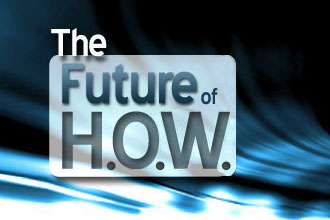How Game Theory Can Change the Industry
 I geek out when I find out new ways of using my smartphone — hidden features or undocumented I-didn’t-know-it-could-do-that shortcuts elicit mini-celebrations and a secret calculation of how much more more value I just got out of the original purchase price. Usually these are shortcuts and features that existed when the phone launched; I’m just late to the party of power-user knowledge.
I geek out when I find out new ways of using my smartphone — hidden features or undocumented I-didn’t-know-it-could-do-that shortcuts elicit mini-celebrations and a secret calculation of how much more more value I just got out of the original purchase price. Usually these are shortcuts and features that existed when the phone launched; I’m just late to the party of power-user knowledge.
Similarly, when I hear from a peer how they use gear I also own, but in an entirely new way, it excites me to think about how I, too, can benefit from this new found application knowledge. This feeling is powerful and it gets me thinking about how else I can use a previously pedestrian component in new, cool ways.
Games, Rewards, and Purchasing Decisions
This is pretty geeky, but there are actual mathematical methods used in the study of strategic decision making, known as Game Theory. One simplified construct of this is Gamification Reward Theory. Popular online games and mobile apps are focused on reward-based progress. From Facebook-based games that have no ending but are merely limitless levels to be conquered, including mobile apps like the insanely popular Candy Crush, reward is the motivator to keep the user playing. Win a level? Get a star. Achieve five ranks in a day? Get a badge. You get the idea.
So, where this intersects the audio, video and lighting industry is in understanding the motivation of the user. But first, let’s think about the basic motivation of every company: more sales and consistent sales. That’s obvious, but what’s less apparent is the amount of time, advertising, pre-sales and sales effort to land a new sale with a new customer or sell a new product to an existing client. This variable is a soft cost or opportunity cost, and is assumed to be a normal part of the purchasing process. For new clients, it may well be, but what would happen if existing clients sold to themselves? That’s where it gets interesting.
Purchase decisions generally align into one of four categories:
- Minor New Purchase — low-importance purchase.
- Minor Re-Purchase — buying from brand loyalty or to maintain consistency in operations/maintenance.
- Major New Purchase — high-importance purchase requiring an extensive decision-making process.
- Major Re-Purchase — confidence-inspired purchase based on previous experience.
But what if there was another method for existing clients to make repeated, consistent recurring purchases and new purchases? That exists; they’re called “customer loyalty rewards” and are used in most of the consumer world.
In the retail world, customer loyalty rewards are commonplace, even from technology vendors. Astonishingly, they’re missing in the professional A/V/L industry. Instead, individual dealers and integrators are more than willing to provide discounted prices (Why? Isn’t a greater value a better win-win?) for large-quantity orders, but there’s not even a thought about rewarding clients that have the opportunity to make repeat purchases over time. There’s only the hope that a salesperson gets lucky when the unexpected, unsolicited purchase order comes in from a client. Hope, my friends, is not a good business strategy.
Tapping Into Buyer Motivation
To rethink the reward system for repeat client business, it helps to first identify their purchase habits, and their purchase history. Hopefully, because you’re in business to make sales again and again, you have a database that tracks the sales of units to clients. If you don’t have this kind of database, we need to have another discussion about the inevitability of going out of business.
Assuming, however, that you do have said database, the significant time and effort required to generate meaningful reports of buyer data is going to be the largest hurdle for most businesses. This is hard, tedious work. And, it extends beyond running a bunch of reports or generating dozens of spreadsheets; the diving into the data, establishing baselines, and measured trends over time is the point of this work. Extrapolating the data and massaging the trend lines will reveal so much about your business, I could spend the next several articles just working through those implications (engineering, design, marketing, sales, service – you’re all affected). However, what you’re looking for are two keys: buyer motivation and buying cycles.
On an aggregate level, even those barely paying attention at your company will know you have certain seasons of sales peaks and valleys. Those are buying cycles. What buyer motivation tells us is far more than when they buy; it tells us why they buy.
What if you could begin to discern some large, generalized buying motivation patterns about the House of Worship vertical market? Most certainly, you’d march right over to your marketing team and find ways to capitalize on this insight.
Now, imagine what would happen if your House of Worship clients starting telling you what’s motivating them? That’s where this is headed.
Reward Users for… Doing Their Job?
The technology already exists. The solution to ‘talk’ with your technology already exists, even (especially) from remote mobile platforms. So what’s missing? Rewarding users whenever they use the gear.
Consider the following scenarios:
- Programming a lighting console? Log in through an app or web-enabled device so that your time and work is documented and your time is rewarded. You just saved a new light plot? Great! A push notification comes through on their mobile device with a new badge or reward icon.
- Mixing audio for three services on a Sunday? Awesome! An automated Tweet from the user’s Twitter account, cataloging the time spent.
- Cycling up the sound system through a control system? Fantastic! An automatic check-in is registered by your username.
Of course, this all sounds like the social gamification systems you’re already using: FourSquare for check-ins, Tweets for new milestones or a new level attained in a game app. We’re simply tying in the life of the techie with their social network, rewarding them for behavior and actions they’re already doing.
This brings me back to the game theory thought process as we begin to explore what motivates clients to make new or repeat purchases.
For some, it’s the challenge of completion. For others, it’s the reward itself, from tangential rewards (one that builds upon itself) to compounding rewards (value increases each time a new level is attained) to calculating rewards (the difficulty of the challenge plus the given effort is the reward level). Whatever the motivation of the user, there’s a gaming methodology reward system that fits.
In the house of worship market, not only will the technical staff love this, their peers at other churches will, too. And that, my friends, is yet another kind of motivation: reward-based usage. Even the church volunteers can get in on the fun with their own login information. From band members using personal monitor mixers to worship leaders firing up their mics and IEM’s, to the IT director who set up the automated backup system for the video editing servers, the church market has a plethora of applications where a rewards-based user system will lead to an entry into the social network of these users and influencers — and that gives your brand a free, endorsed presence to their circle of friends and peers.
Taking it to the next logical step, capturing this data and using it to send automated email sales follow-up to end-users provides a feedback loop mechanism to solicit their NPS (Net Promoter Score), understand their current satisfaction with the gear they purchased, and even allow them to self-direct their interest in your other/new technology options. All of this is platinum-coated marketing and pre-sales goodness.
Smart phones were the beginning of the Internet of Things, which by the way, is the Next Big Thing. The audio, video, and lighting industry needs to get on board this train to tomorrow. The house of worship market will not be the only vertical segment to benefit, but it is an ideal one based on the power of brand endorsement to an market where peer recommendations carry significant purchasing weight.
Which brands/tools in the A/V/L space have started down this path? Comment below.





